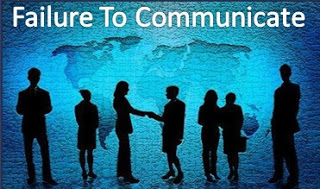This week's favorite post is all about communications. It is a great reminder that communications is one of the most critical elements for the success or failure of any business. It is also the key component for a satisfying and fulfilling personal life with family and friends.
· Favorite post from this past week: From Harvard Business Review "The Silent Killer of Big Companies" ow.ly/eOUhq
The Harvard Business Review blog provides the following examples of the silent communication killer of big companies:
- Nokia – For a decade plus, Nokia was the world's market leader in mobile phones. They missed the smarphone wave due to "habits of communication that favored unfocused discussions about strategy over clear plans to bring new phones to the market."
- Enron – Their collapse attributed to several "communications based leader responsibilities" that senior management failed to meet.
- Star Princess Cruise Lines – In April 2012, passengers on one of its cruises spotted a fishing boat in distress and alerted the crew. Ship did not stop and two people died on the fishing boat. The cruise line issued a statement citing a "breakdown in communication in relaying the passengers' concerns."
- British Petroleum – According to a White House report, among the factors leading to a blowout of the Deepwater Horizon oil rig in April 2010 were "poor communications" and a failure to "share important information."
- Thai Airways – Reasons why the CEO of Thai Airways lost his job in May 2012 included "communications problems between Piyasvasti (CEO) and the board" which led to missed profit targets.
The authors of the Harvard Business Review article are correct that examples abound for poor communications. Failure to communicate is actually getting easier as social media and mobility grow in importance. If you are doing a poor job at communications, new technologies will highlight your flaws faster. Vigilant tracking and response strategies are becoming critical to protect both company and personal reputations.
For progressive companies that understand the core value of effective communications, the opposite is also true. We are on the verge of new innovative approaches to reach new audiences, new customers / new markets through new high tech communication tools. With proper execution, "failure to communicate" issues will actually get harder. Here are three examples of new emerging technology communication approaches from this past week:
- This post is being published as the election of the next USA President is taking place. A subtle, but powerful change took place this election cycle with the extensive focus on voter outreach programs through the Internet. Estimates on how much is being spend online to reach voters range from $160 million (6 times higher than 2008) to $300 Million. About 10% of campaign donations have been made via mobile phones. Every single social media platform is being utilized to reach voters. Both campaigns have databases that they are mining extensively. Your tweeting or blogging patterns mean that the person next to you with that Smartphone or Ipad is getting a totally different message from the candidates based on their online preferences. (Economist, November 3, 2012).
- On multiple occasions have forwarded TED videos. Technology, Entertainment, Design (TED) started in 1984. In the next 30 days, the one billionth download of an online TED speaker video will take place. Online and social media have played a key role in the popularity of the TED network to disseminate business, scientific, and motivational video content. Just like Wikipedia, the internet community adopted the TED content / concept and globalized it. (Economist, November 3, 2012). Video will replace photos as visuals being uploaded to the Internet. The growth of video will mean more storage, more video / data analytics software to make business sense of all the content.
- Public diplomacy has a new vehicle in China – the microblog. In 2011, the number of microblogs from foreign governments surged to 165. The British Council has the most popular microblog in China with 954,000 followers. USA government agencies have the next three most popular sites with almost 2 million followers across all three entities. Even individual foreign nationals are focusing on building their personal brand in key emerging markets. The top three foreign nationals on Sina Weibo, the Chinese version of Twitter, are Christine Lagarde (IMF chief) with 1.6 million followers, Herman Von Rompuy (European Council President) with 1.34 million followers, and Kevin Rudd (former Australia prime minister) with 340,000 followers. In Rudd's case, the popularity of his posts are translating into prominence back into Australia where the Chinese account for 4% of the population. (China Daily, November 3-4, 2012).
Above three simple examples portend major future positive communications trends / opportunities for both business and personal brands. New communication technologies are transcending borders and consumer cultures. These communications tools can strengthen the core brand, expand its market reach, and with the right mix engage new customers to buy your solution.
As this week's Harvard Biz post concludes, successful leaders:
- Adopt communications that enable them to get closer to employees.
- Put in place communications systems that promote dialogue as opposed to monologue.
- Engage employees by allowing them to become active participants in the communication process.
- Pursue an agenda that aligns their communication efforts with organizational strategy.
All good ideas to which would add a more balanced approach of blending legacy and new emerging approaches to future communications strategies.
Have a clear vision of what you are trying to communicate, leverage the new tools available, creatively spin them to match your goals, innovate beyond the base possibilities, focus on your audience, and understand they are getting over messaged. Above all, think value proposition in all aspects of your outreach programs.
Failure to communicate is getting much harder, if you understand the possibilities around you to creatively break through the noise to success.

(*) The title of this week's blog is from the movie Cool Hand Luke (1967), starring Paul Newman.
















